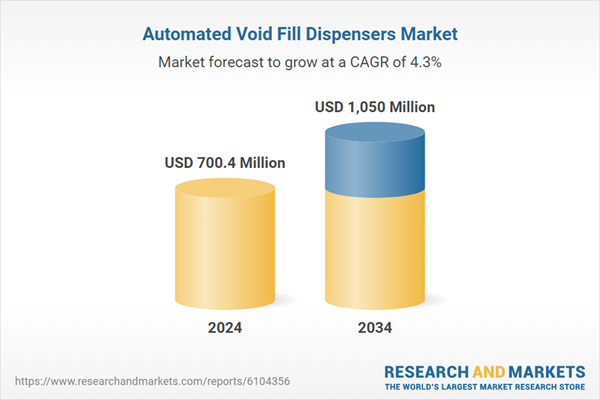Technological advancements, such as the integration of AI and IoT, are revolutionizing machine performance by enabling real-time data monitoring, predictive maintenance, and seamless connectivity across production lines. These smart capabilities not only boost efficiency and accuracy but also reduce downtime and operational costs. As a result, these intelligent systems have become indispensable in modern, automated packaging facilities, where speed, precision, and adaptability are critical to meeting ever-growing demands and maintaining competitive advantage.
In 2024, the fully automated segment dominated the market, generating USD 406.2 million in revenue and is expected to grow at a CAGR of 4.7% through 2034. This segment’s expansion is fueled by industries seeking labor-saving, efficient packaging solutions capable of handling high volumes. Fully automated dispensers precisely control material output, reducing waste and boosting sustainability efforts. Their growing adoption in smart warehouses and manufacturing plants is propelled by the integration of advanced automation technologies like AI and IoT, which improve overall productivity and operational efficiency.
The paper-based segment held a 43% share in 2024, generating significant revenue and is anticipated to grow at a CAGR of 4.5% during 2025-2034. Paper-based void fill dispensers are favored due to their recyclable nature and alignment with increasingly strict environmental standards. As regulations tighten, companies across the e-commerce and packaging industries are phasing out non-recyclable and toxic materials in favor of eco-friendly alternatives, making paper-based systems the preferred choice.
United States Automated Void Fill Dispensers Market held 79% share and generated USD 165.3 million in 2024. The country’s focus on sustainability and eco-conscious manufacturing has driven strong demand for paper-based void fill solutions. Additionally, the shift toward smart factories and automation supports the uptake of fully automated dispensers equipped with smart features like AI-powered vision systems and IoT connectivity to boost efficiency and throughput in packaging operations.
Key players competing in the Global Automated Void Fill Dispensers Market include EcoEnclose, Ranpak, IPG, Papier Sprick, Storopack Hans Reichenecker, Crawford Packaging, HexcelPack, The Packaging Club, Pregis, Kite Packaging, Ashtonne Packaging, Omni Group, Fromm Packaging Systems, Zepak, and Sealed Air. To strengthen their market presence, leading companies are investing heavily in R&D to enhance machine accuracy, speed, and energy efficiency. They are focusing on integrating cutting-edge AI and IoT technologies to enable real-time monitoring, predictive maintenance, and seamless connectivity with other packaging systems.
Strategic partnerships with packaging manufacturers and e-commerce companies help these players customize solutions for specific client needs. Furthermore, expanding product portfolios to include sustainable and recyclable void fill materials supports their commitment to environmental compliance. Offering training, after-sales support, and flexible financing options also helps companies build long-term client relationships and expand their footprint in emerging markets.
Comprehensive Market Analysis and Forecast
- Industry trends, key growth drivers, challenges, future opportunities, and regulatory landscape
- Competitive landscape with Porter’s Five Forces and PESTEL analysis
- Market size, segmentation, and regional forecasts
- In-depth company profiles, business strategies, financial insights, and SWOT analysis
This product will be delivered within 2-4 business days.
Table of Contents
COMPANIES MENTIONED
The companies featured in this automated void fill dispensers market report include:- Ashtonne Packaging
- Crawford Packaging
- EcoEnclose
- Fromm Packaging Systems
- HexcelPack
- IPG
- Kite Packaging
- Omni Group
- Papier Sprick
- Pregis
- Ranpak
- Sealed Air
- Storopack Hans Reichenecker
- The Packaging Club
- Zepak
Table Information
| Report Attribute | Details |
|---|---|
| No. of Pages | 220 |
| Published | June 2025 |
| Forecast Period | 2024 - 2034 |
| Estimated Market Value ( USD | $ 700.4 Million |
| Forecasted Market Value ( USD | $ 1050 Million |
| Compound Annual Growth Rate | 4.3% |
| Regions Covered | Global |
| No. of Companies Mentioned | 16 |









